GET IN TOUCH
- Please wait...

The Bangladesh Leather Industry has been one that has shown glimmers of promises over the years. It is worth around USD 1.90 billion with 40% of the total demand being met from imports. [1] It is the second-largest export sector for Bangladesh. In addition to this, the quality of exported leather is generally lauded by foreign buyers. Despite this, the industry has failed to develop into a thrust sector on par with Apparel & Ready Made Garments.
Around 155 tanneries are present in Bangladesh.[2] However, it is estimated that at least 40% of the supply of raw-hide comes from the seasonal peak during the time of Eid-ul-Adha.[3]. Around 85% of leather and leather products exported are in the form of crushed leather, blue wet leather, finished leather, leather garments, and footwear.[1]
The value chain of leather products is a long-winded one which prevents easy scaling-up for businesses in the sector without investing heavily on capital and workforce training.

Compliance with global standards of workplace and work-environment safety has been a persistent problem with the industry that has bored down on export revenue targets. Some foreign buyers have suspended importing leather and leather products from Bangladesh due to the failures in compliance with environmental standards. In response to this problem, many firms relocated to the Savar area from Hazaribagh (the former heart of the industry) on grounds of avoiding further pollution of the Buriganga River. A Central Effluent Treatment Plant (CETP) has been established in Savar to further meet compliance standards.
The relocation process had begun in 2003 with an estimated cost of BDT 175.75 crore, excluding the cost of CETP.[5] However, implementation is not yet complete of the Savar Tannery Park and it is expected that it will not be able to meet the requirements of the peak seasonal fluctuation during Eid time.
The raison d’etre of the relocation itself seems to be in question, with the Savar tanneries releasing both liquid and solid waste into the neighbouring Dhaleshwari River.
The Park Design is now being adjusted as per the requirements of the Leather Working Group (LWG), a platform comprising brands, manufacturers, suppliers, NGOs and end-users dedicated to developing and maintaining, and assessing environmental compliance as well as performance capabilities of leather manufacturers.
COVID-19 has significantly hit the already declining exports of the sector. The low number of work orders has meant that only 30% of the 155 established tanneries at Savar are currently operational.[2] Demand from foreign buyers like China remains stipulated with low asking prices which are not conducive to profits for the tanneries. Significant credit crunches for the sector have meant that the industry must rely on government support to help them through this period of turbulence.

The Bangladesh Tanners Association (BTA) has recently sought BDT 600 Crore from the government to smoothen the impact of the capital crisis in the country.[2] In addition to this, a moratorium to previous loan payments was also sought.
A recent Bangladesh Bank circular has now provided a lifeline to the industry through a new loan rescheduling scheme. Defaulting tanners will be allowed to reschedule their classified loans by making a downpayment of 2 percent, and take fresh loans to purchase rawhides of sacrificial animals in the upcoming Eid-ul-Adha. The payback tenure is 6-8 years for these types of loans.
In addition, the problem with tanneries being unable to avail the benefits of the stimulus package due to its stringent criteria has been somewhat eased as they will now be able to take loans from the package designated for industries at 5% interest. [6]
It has been proposed that the price of raw-hides in the Eid season may be fixed to allow the tanneries to earn sufficiently. The Bangladesh Bank also asked the banks to be flexible in taking collateral from leather industry entrepreneurs against their loans and provide loans on a priority basis.
The Bangladesh Trade and Tariff Commission has proposed prices of cow rawhides fixed at BDT30-BDT40 per square feet and those of goats at BDT15-25 per square feet. Last year, the prices of rawhides of cows and goats were BDT45-50 and BDT18-20 respectively.[6]

Though such preferential treatment may allow the industry to survive and stay afloat, there is a cause for concern regarding the implications of these benefits on long term loan defaults for the industry. Currently, defaults in the sector amounted to about BDT 32.5 billion, most of which are long-term debts. This is a glaring statistic as the disbursed loans to the industry are a little over estimated BDT40 billion. State-owned commercial banks account for 90% of the bad debt.[7]

Allowing for less stringent loans to a sector already so submerged in defaulting debt may be risky and may cause further problems for the country’s already suffering banking sector. The Loan Rescheduling facility is government-secured and in the case of defaults, may raise external debt further on top of the already-high budget deficit figure for the FY 20-21. Care must be taken if we are to avoid spiralling into another financial crisis.
The way ahead for the sector is one that must be deliberated extensively before implementation. However, there are certain key areas to prioritize.
Sartaz Zahir, Content Writer at LightCastle Partners, has prepared the write-up. For further clarifications, contact here: [email protected].
– The article is based on data collected from before this year’s Eid al Adha
Our experts can help you solve your unique challenges
Stay up-to-date with our Thought Leadership and Insights